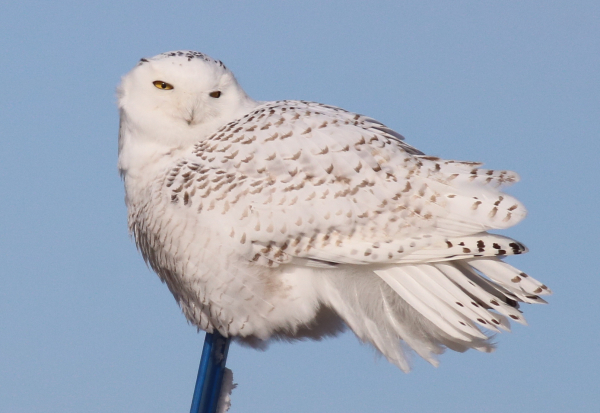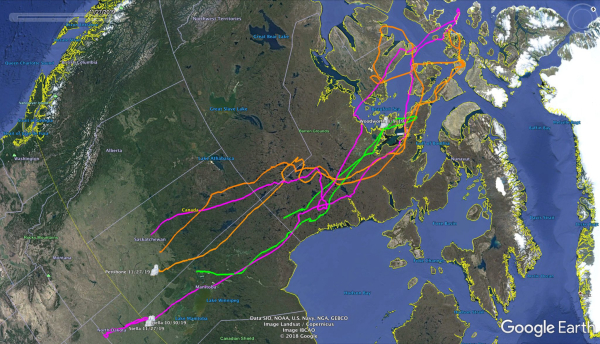

|
Project SNOWstorm is celebrating its seventh year studying the movements and ecology of Snowy Owls, and this promises to be one of the most interesting years. A number of radio-tagged Snowy Owls have already migrated south from the Arctic, adding new information for ongoing research and showing some fascinating results from new hybrid transmitters. There have already been good numbers of snowy owls showing up in the northern prairies from Alberta to North Dakota, across the Great Lakes and down the Atlantic Coast as far as New York.
The best news is that three tagged Snowy Owls have migrated south, bringing with them recorded data that show their movements during the past seven to eight months in the Arctic. The transmitters used rely on relaying location data via cellular antennas, which are almost absent from their summer range in the Arctic. When the owls return south of the boreal forest, where more cell antennas are located, the transmitters begin downloading information which is recorded daily when the owls are within range of a cell antenna.
Three Snowy Owls reappeared rather early in the fall: The evening of October 23, messages indicated two of the owls checked in electronically when their transmitters began downloading automatically as they came into range of the first cell antenna since April. These were among the earliest returns recorded, part of a significant movement of Snowy Owls into the northern Plains in October on the heels of some harsh winter weather, including an early blizzard in the Dakotas.
One of the Snowy Owls, a two-year-old male dubbed ‘Woodworth’ was captured and tagged by wildlife biologist Matt Solensky last winter in central North Dakota. After leaving the open plains last April, it migrated far north to the Boothia Peninsula, then backtracked to King William Island in mid-June. His movements thereafter were spread across thousands of acres, with three focal points many kilometers apart. After returning to the open prairie south of the northern forests, his transmitter began downloading almost 9,000 backlogged GPS points. His most recent transmitted location was in Manitoba north of Lake Winnipeg, but unfortunately, because its transmitter battery was drained so low, no recent movement date has been available, but it’s expected this wide-ranging owl has continued southward.
An adult male Snowy that was also tagged in central North Dakota by Solensky in 2018, called Pettibone, showed up November 13 in southeastern Saskatchewan near the town of Kelvington. According to the transmitter data downloaded then, this adult also spent the summer in the Canadian Arctic Archipelago, wandering across Cornwallis and Bathurst Islands. Unlike the summer of 2018, when we suspect he found a mate and nested on Banks Island, this summer his movements indicated he did not stay in one location to nest. By the end of September he was well on his way south, and by the time he reconnected with a GPS antennae he’d made a round trip just shy of 3,700 miles!
The third owl to reveal its summer movements is referred to as Stella, a three-year-old female Snowy Owl tagged in January 2018 on Amherst Island near the northeast shore of Lake Ontario. After spending the summer of 2018 on Victoria Island in the Canadian Arctic, she returned south November 15, 2018, first checking in from southern Saskatchewan. She spent last winter in northeast Montana, then migrated north for the summer of 2019 to Lougheed Island, one of the most remote and northern parts of the Canadian Arctic Archipelago. Last month she was back south in southern Manitoba when she first transmitted north of the town of Boissevain, only about 25 miles north of the North Dakota border.
This female was last heard from her last spring on April 11 near Prince Albert, Saskatchewan, just before she reached the southern edge of the boreal forest. From there, over the next month she flew north-northeast, crossing into Nunavut and looping around the western margin of Hudson Bay in late May before angling north through the Queen Maude Bird Sanctuary. Then she crossed to Victoria Island, an immense piece of Arctic real estate the size of England, Wales, and Scotland that holds fewer than 2,500 people.
That’s where this active female Snowy spent the summer of 2018, but she didn’t stop on Victoria this year. In mid-June she crossed 85 miles of icy water to reach Melville Island, and continued farther north to uninhabited Lougheed Island, one of the most isolated parts of the Canadian Arctic Archipelago. She made one foray out from the northern tip of Lougheed toward the edge of the Canadian Arctic on June 24, but turned back to the island, having flown more than 1,900 miles since April. Through July and August she moved southward, picking up speed by the end of September and the first weeks of October.
When she reached cell range in Manitoba, she kept moving south, stopping at a number of locations as she crossed North Dakota. On November 13 she stopped near the town of Lemmon, just across the border in South Dakota, but something must not have suited her in the south. After spending more time re-crossing North Dakota she ended up in southern Manitoba near Whitewater Lake, which is where she’s been ever since – apparently she prefers Canada this season.
One thing is clear from this owl’s constant travel while she was in the Arctic last summer – she didn’t attempt to nest this year, but she’s only a three-year-old Snowy. While experts aren’t sure when Snowys begin to nest, they suspect it may not be until age four. Nonetheless, this is the kind of information that is being revealed and much more information will be learned from these and many other radio-tagged Snowy Owls. Already, their movements and survival rates are extremely interesting, and their nesting behavior is slowly being revealed – year by year.
For more information about Project SNOWstorm and other tagged Snowy Owls as they return from the Arctic to reveal more exciting information, refer to https://www.projectsnowstorm.org/posts/a-new-season-a-lot-of-news/